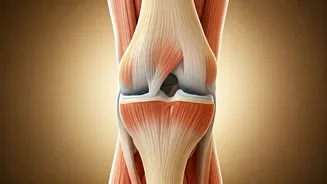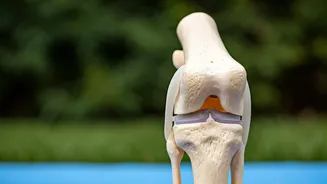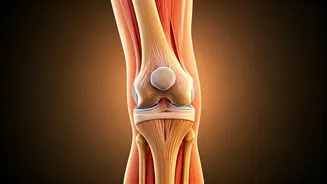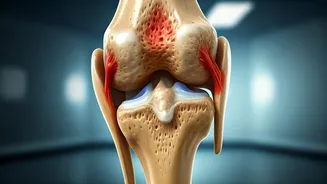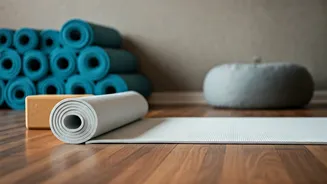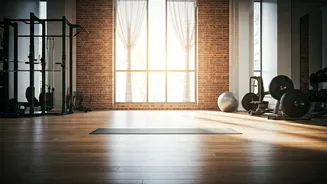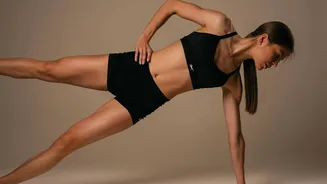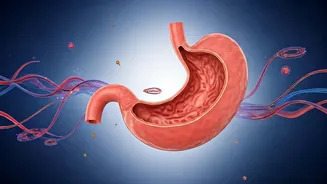Understanding Knee Pain
Knee pain can arise from a myriad of causes, ranging from the wear and tear of osteoarthritis to injuries sustained during physical activities. The symptoms
often include stiffness, swelling, and a sharp or dull ache that can impact daily activities. Common issues such as meniscus tears, ligament strains, and patellar tracking problems are frequent culprits behind this pain. Furthermore, the severity can fluctuate depending on the level of activity, weather changes, and the overall condition of the supporting muscles. Ageing also plays a role, with cartilage degradation and reduced joint lubrication contributing to increased pain levels. Understanding the root cause of the discomfort is the first crucial step towards finding an effective relief strategy. When dealing with knee pain, it’s beneficial to consult with a healthcare professional to get an accurate diagnosis and consider implementing tailored exercises, such as yoga, for long-term health.
Tadasana: Mountain Pose
Tadasana, or the Mountain Pose, serves as the foundation for numerous standing yoga asanas. In this pose, you stand tall with your feet firmly planted on the ground, toes and heels slightly apart. The key is to engage your core muscles, lift your chest, and relax your shoulders away from your ears. The pose is deceptively simple but incredibly powerful, as it helps improve posture, balance, and body awareness. To execute Tadasana correctly, focus on maintaining a neutral spine, with your weight evenly distributed across both feet. Feel the ground beneath you and visualise a line of energy extending upwards through the crown of your head. Regular practice of this pose improves the strength of the supporting muscles around the knees while improving alignment. This alignment is vital as it prevents uneven pressure on the knees, lessening the risk of pain.
Virabhadrasana II: Warrior II
Virabhadrasana II, or Warrior II pose, is a dynamic asana that strengthens the legs, ankles, and knees. To begin, stand with your feet wide apart, approximately one leg-length distance. Turn your right foot out to a 90-degree angle and your left foot slightly inwards. Bend your right knee until it is over your ankle, ensuring your thigh is parallel to the floor. Keep your back straight, your gaze focused over your right hand, and your arms extended in a straight line. This pose activates various muscle groups, including the quadriceps, hamstrings, and inner thighs, all of which support the knee joint. Warrior II is effective because it not only increases strength but also enhances flexibility, making the knees more resilient to stress. Regular practice can improve the range of motion and reduce the pain associated with conditions such as osteoarthritis. Remember to switch sides, performing the pose with your left leg forward as well.
Setu Bandhasana: Bridge Pose
Setu Bandhasana, or Bridge Pose, is a gentle backbend that strengthens the back muscles, glutes, and hamstrings, all of which contribute to knee stability. To perform this asana, lie on your back with your knees bent and feet flat on the floor, hip-width apart. Your arms should be at your sides, palms facing down. Inhale and lift your hips off the floor, engaging your glutes and core muscles. Try to keep your thighs parallel to each other and your chest lifted. Hold the pose, breathing deeply, and feel the stretch across your chest and shoulders. The bridge pose supports knee health by promoting a strong core and flexible spine. These enhancements indirectly support knee alignment and reduce pressure, leading to pain relief. By improving core strength, you distribute the weight more evenly, placing less burden on your knees. Gently release and return to the floor to complete the asana.
Anjaneyasana: Low Lunge
Anjaneyasana, or the Low Lunge, provides a good stretch for the hip flexors, quadriceps, and hamstrings. Start on your hands and knees, then bring your right foot forward between your hands. Ensure your right knee is directly over your ankle. Slide your left knee back until you feel a stretch in your left hip flexor. Keep your torso upright, your shoulders relaxed, and your gaze forward. This pose, when practiced regularly, enhances flexibility and strengthens the muscles around the knees. By loosening the hip flexors, the low lunge reduces tightness that can pull the pelvis out of alignment, which, in turn, can affect knee function. Additionally, the controlled stretch provides an excellent opportunity to improve balance and body awareness, vital for injury prevention. Repeat the pose on the other side, bringing your left leg forward. Proper form is crucial; keep your back straight and avoid overextending the stretch.
Viparita Karani: Legs-Up
Viparita Karani, or Legs-Up-the-Wall Pose, is a restorative posture that can help reduce knee pain and swelling by improving circulation. To execute this pose, sit close to a wall with your left side touching it. Gently turn and swing your legs up the wall, positioning your sit bones as close as possible. Your legs should be straight, and your body should form an ‘L’ shape. Relax your arms at your sides, palms up. This pose gently stretches the hamstrings and helps to alleviate lower back and knee pressure. By reversing the effect of gravity, this asana encourages venous return, which can reduce swelling in the legs and feet, thus indirectly easing knee discomfort. It also promotes relaxation and stress reduction, which can help manage pain perception. Stay in this pose for about 5 to 15 minutes, breathing deeply and letting your body relax completely. Feel the soothing effects as your body unwinds.
